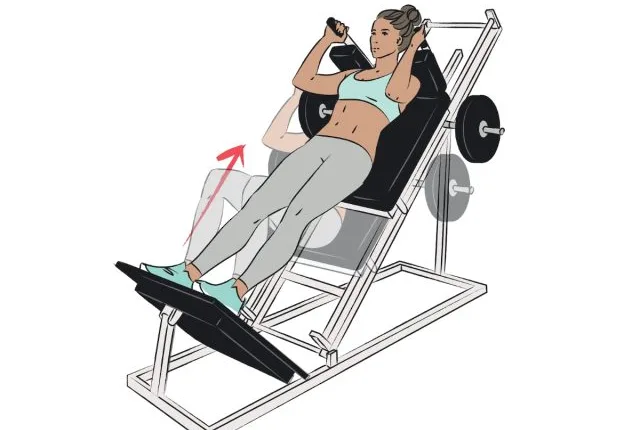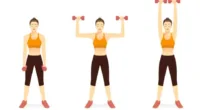Switching up your leg day routine can help you avoid plateaus and keep your workouts interesting. In addition to the classic leg exercises mentioned above, you can incorporate exercises like Bulgarian split squats, step-ups, and hip thrusts into your routine. These exercises target different muscles in your lower body and can help improve your overall lower-body strength and stability.
Research suggests that increasing your lower-body strength can improve mobility, stability, and athletic performance while supporting joint health and boosting metabolism. It also improves functional strength for daily activities and promotes better posture and overall well-being. So next time you consider skipping leg day, think again.
But what are the best “leg day” exercises? We’re glad you asked. We spoke with Mike Masi, CPT, a certified personal trainer at Garage Gym Reviews, who shares their top 10 picks for the best leg exercises. The best part is there’s no wrong way to use these exercises. Pick some or all of the exercises and incorporate them into your next “leg day” session. The key is finding leg exercises that you will stick with and that work best for you and your fitness goals.
Prone Hamstring Curl Machine
The prone hamstring curl machine targets the hamstrings with precision, giving them a deep stretch and controlled contraction.
“This exercise is performed lying face down on a hamstring curl machine,” Masi explains. “The trick with this machine is not to go too heavy. Instead, focus on milking the deep stretch at the end range of motion with lighter weight. When you curl the weight up, be careful not to lift your hips and over-engage the lower back.”
Lie face down on the machine, aligning your knees with the machine’s pivot point. Grip the handles and position your ankles under the padded bar. Slowly curl your legs toward your glutes, squeezing your hamstrings at the top. Lower back down with control to the starting position. Aim for four sets of 15 to 20 reps with 60 seconds of rest between sets.
Hack Squat
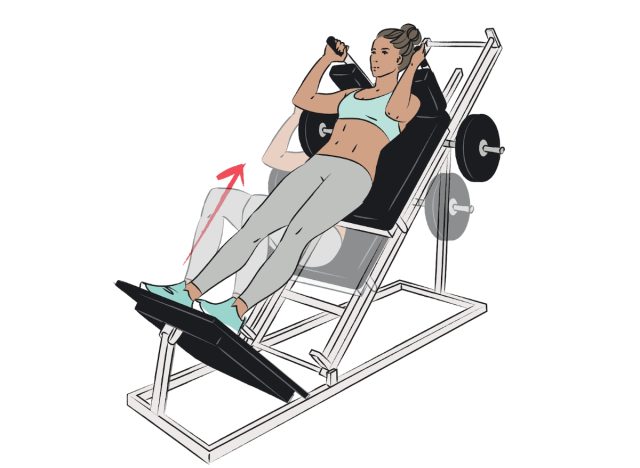
Hack squats engage your quads, which can help boost your lower-body strength and stability.
See also 5 Fat-Burning Workouts You Can Do Anytime, Anywhere
Masi tells us, “This machine-based squat variation is like squatting using a Smith machine. During hack squats, you can place your feet slightly out in front of you without fear of falling backward. This allows for more squat depth and better quad activation than when under a traditional barbell back squat.”
Stand on the hack squat machine with your back against the pad and shoulders under the shoulder pads. Place your feet shoulder-width apart, slightly in front of your body. Lower your body by bending your knees and keeping your back flat against the pad. Push through your heels to return to the starting position. Perform four sets of 10 to 12 reps, resting for 60 seconds between sts.
Walking Lunges
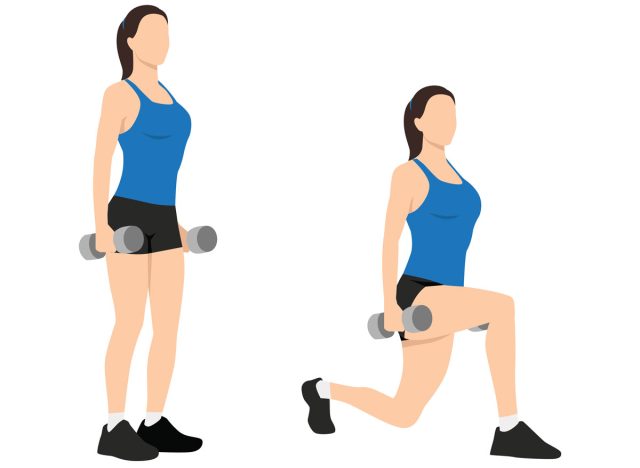
This dynamic exercise is a stellar way to activate your quads, glutes, and core.
“Walking lunges engage more glutes than traditional squats due to the narrower support base. Have fun loading this in various ways, using weights at your side, or in a front rack position, or even holding a weight overhead,” says Masi.
Stand with your feet hip-width apart, holding weights at your sides or no weights for beginners. Step forward with one foot, lowering your hips until both knees are bent at about 90 degrees. Push through your front heel to bring your back foot forward, standing up into the next lunge. Continue stepping forward, alternating legs with each lunge. Perform three sets of 12 to 15 reps per leg. Rest for 90 seconds between sets.
Belt Squat
The belt squat is an underrated squat variation that allows you to train your legs with intensity without straining your back.
“This squat variation is performed using a belt squat machine, focusing on the lower body while reducing axial fatigue,” explains Masi. “Axial fatigue refers to the stimulus you must recover from when loading the spine. Because the load from the belt squat is almost completely added at the hips, you can freely train your legs without the extra fatigue of the various muscles having to brace along the spine.”
Attach the belt squat harness around your hips and secure it to the machine. Stand on the platform with feet shoulder-width apart. Lower your body by bending your knees and hips, keeping your chest up and back straight. Push through your heels to stand back up, returning to the starting position. Complete three sets of 12 to 15 reps with 90 seconds of rest between sets.
See also Types of Stroke And Treatment: What You Need To Know And Signs
Romanian Deadlift (RDL)
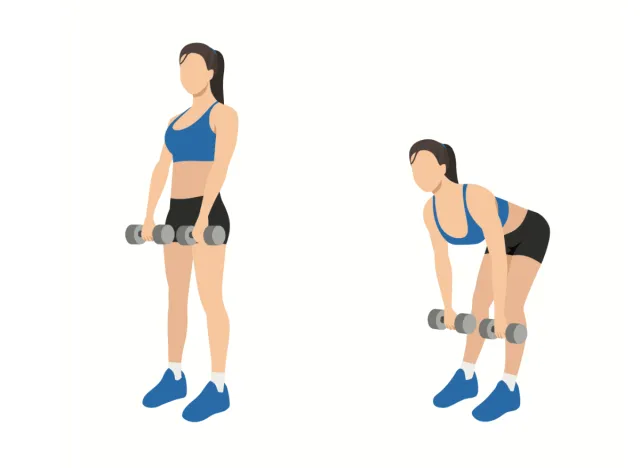
Romanian deadlifts are a classic compound movement that works the hamstrings, glutes, and lower back.
Masi says, “This exercise emphasizes the hip hinge movement pattern and allows you to focus on loading the posterior chain (backside), specifically the hamstrings and glutes. If you’re flexible, consider standing on a step or a plate to get extra range of motion before the weights touch the ground.”
Stand with your feet hip-width apart, holding a barbell or pair of dumbbells in front of your thighs. Keep your knees slightly bent, hinge your hips to lower the weights toward the ground, and maintain a flat back. Lower until you feel a stretch in your hamstrings, then drive your hips forward to return to the starting position. Do four sets of eight to 12 reps, resting for 90 seconds between sets.
Thrusters
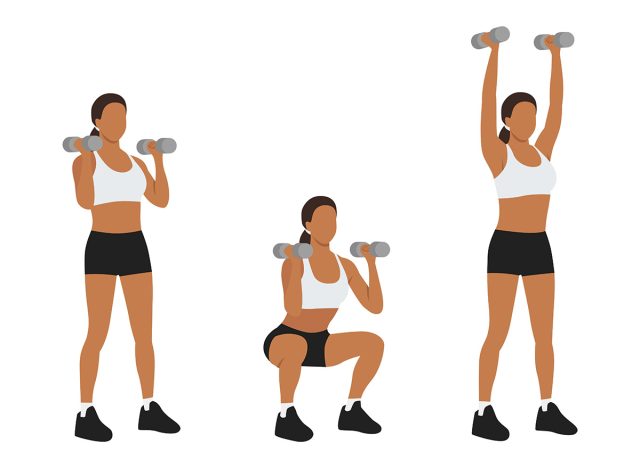
Thrusters combine a front squat with an overhead press to deliver a full-body exercise that challenges your legs, glutes, shoulders, and core.
However, Masi says this exercise isn’t for the faint of heart. “If you don’t get out of the squat fast enough, the weight may never end up making it overhead. That focus on the force production rate can help improve strength,” he stresses.
Hold a barbell or set of dumbbells at shoulder height and stand with your feet shoulder-width apart. Perform a front squat by lowering your hips until your thighs are parallel to the ground. Stand up explosively by using your momentum to press the weights overhead. Lower the weights back to shoulder height and repeat. Aim for three sets of 10 to 12 reps with 90 seconds of rest between sets.
Hip Thrust
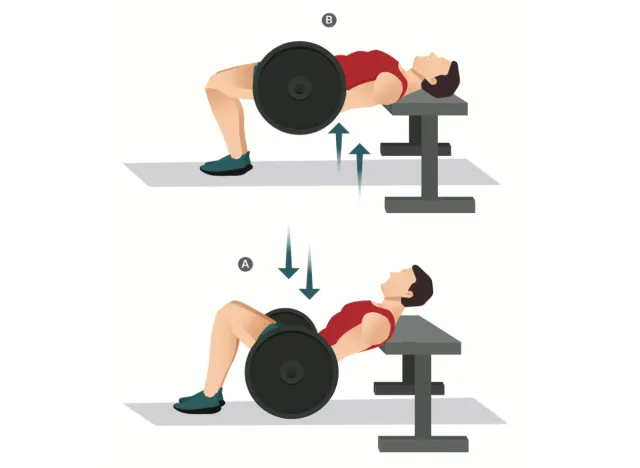
Hip thrusts are the go-to exercise for targeting your glutes and hamstrings.
“This movement is traditionally performed with a barbell. The glutes are strong, and there isn’t a better way to isolate them while still loading them to this degree. If you’re trying to grow your glutes, this should be a staple in your programming,” says Masi.
Sit on the ground with your upper back against a bench and a barbell positioned over your hips. Roll the barbell to rest on your hips, then drive through your heels to lift your hips toward the ceiling. Squeeze your glutes at the top, then lower your hips back to the ground with control. Repeat for four sets of 10 to 15 reps. Rest for one minute between sets.
See also 15 Easy, Effective Workouts To Do on Vacation
Leg Extensions
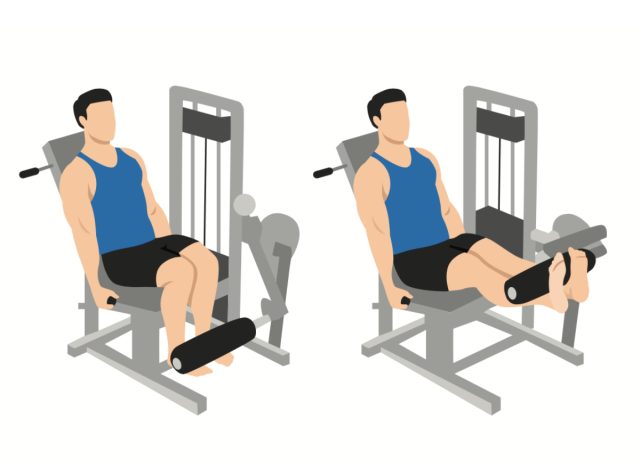
Leg extensions are a fantastic exercise for isolating and growing your quads.
Masi suggests, “Push the seat back and lean backward to get your hips as neutral as possible for better hypertrophy gains. The added stretch to the rectus femoris will further increase the stimulus.”
Sit on a leg extension machine and adjust the pad to rest on your shins just above your ankles. Grip the handles and extend your legs fully, squeezing your quads at the top. Lower the weight back down with control to the starting position. Perform three sets of 12 to 15 reps, resting for 90 seconds between sets.
B-stance Squat
“This squat variation involves staggering one foot behind the other, placing more emphasis on one leg at a time while engaging the glutes and quads,” Masi explains. “This targets muscles similar to the Bulgarian split squat, but it can be loaded heavier and requires much less flexibility and balance.”
To perform this move, stand with one foot slightly in front of the other as if performing a staggered stance. Lower your hips by bending both knees, keeping your chest up and back straight. Push through the heel of your front foot to stand back up. Complete four sets of 10 to 12 reps per leg. Rest for 60 seconds between sets.
Calf Raises
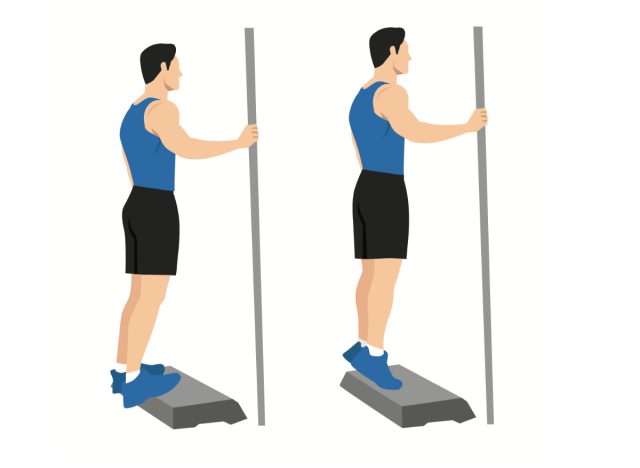
This versatile isolation exercise can be performed in a variety of ways.
“Ideally, you should do calf raises on a leg press or a machine built specifically for calf raises. However, they can also be done on a Smith machine while standing on a step,” says Masi.
Stand with the balls of your feet on the edge of a step or platform and your heels hanging off. Hold onto support for balance and lower your heels below the step level, feeling a stretch in your calves. Push through the balls of your feet to lift your heels as high as possible. Lower back down slowly to the starting position. Do four sets of 12 to 15 reps, resting for 60 seconds between sets.
Frequently Asked Questions (FAQs)
What are the benefits of ‘Leg Day’ exercises?
Engaging in ‘Leg Day’ exercises offers numerous benefits, including strengthening the lower body muscles, improving balance and stability, enhancing athletic performance, boosting metabolism, and promoting overall functional fitness.
How many ‘Leg Day’ exercises should I include in my routine?
It is recommended to include a variety of exercises targeting different muscle groups within the lower body on ‘Leg Day’. A good starting point is to aim for about 4-6 different exercises to ensure comprehensive development of the leg muscles.
Can I perform ‘Leg Day’ exercises at home without equipment?
Yes, there are plenty of ‘Leg Day’ exercises that can be done at home without the need for specialized equipment. Bodyweight exercises like squats, lunges, and calf raises are effective options. Additionally, using household items like chairs or resistance bands can add variety and intensity to your at-home leg workout.
How often should I incorporate ‘Leg Day’ into my workout routine?
The frequency of ‘Leg Day’ in your workout routine can vary depending on your fitness goals and overall training program. Generally, incorporating ‘Leg Day’ once or twice a week can be beneficial for most individuals to allow for proper recovery and muscle growth.
Are there specific tips to maximize the effectiveness of ‘Leg Day’ exercises?
To optimize the effectiveness of your ‘Leg Day’ exercises, it is important to focus on proper form and technique, progressively overload the muscles by increasing weights or repetitions, prioritize compound movements like squats and deadlifts, incorporate sufficient rest periods between sets, and ensure adequate nutrition and hydration to support muscle recovery and growth.

